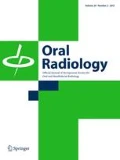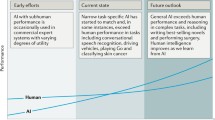Abstract
This report aims to summarize the fundamental concepts of Artificial Intelligence (AI), and to provide a non-exhaustive overview of AI applications in dental imaging, comprising diagnostics, forensics, image processing and image reconstruction. AI has arguably become the hottest topic in radiology in recent years owing to the increased computational power available to researchers, the continuing collection of digital data, as well as the development of highly efficient algorithms for machine learning and deep learning. It is now feasible to develop highly robust AI applications that make use of the vast amount of data available to us, and that keep learning and improving over time.


Reproduced from Poedjiastoeti and Suebnukarn under a Creative Commons Attribution Non-Commercial License [12]

Adapted from Murata et al. with permission by the Japanese Society for Oral and Maxillofacial Radiology and Springer Nature Singapore [13]

Reproduced from Lee et al. under a Creative Commons Attribution Non-Commercial License [16]

Adapted from Krois et al. under a Creative Commons Attribution 4.0 International License [17]

Adapted from De Tobel et al. with the author’s permission [20]

Adapted from Chen et al. under a Creative Commons Attribution 4.0 International License [23]

Adapted from Hu et al. with permission from John Wiley and Sons [25]
Similar content being viewed by others
References
Recht M, Bryan RN. Artificial Intelligence: threat or boon to radiologists? J Am Coll Radiol. 2017;14:1476–80. https://doi.org/10.1016/j.jacr.2017.07.007.
Kohli M, Prevedello LM, Filice RW, Geis JR. Implementing machine learning in radiology practice and research. AJR Am J Roentgenol. 2017;208:754–60. https://doi.org/10.2214/AJR.16.17224.
Clarke AM, Friedrich J, Tartaglia EM, Marchesotti S, Senn W, Herzog MH. Human and machine learning in non-Markovian decision making. PLoS One. 2015;10:e0123105. https://doi.org/10.1371/journal.pone.0123105.
Plis SM, Hjelm DR, Salakhutdinov R, Allen EA, Bockholt HJ, Long JD, et al. Deep learning for neuroimaging: a validation study. Front Neurosci. 2014;8:229. https://doi.org/10.3389/fnins.2014.00229.
Houssami N, Lee CI, Buist DSM, Tao D. Artificial intelligence for breast cancer screening: opportunity or hype? Breast. 2017;36:31–3. https://doi.org/10.1016/j.breast.2017.09.003.
Lakhani P, Sundaram B. Deep learning at chest radiography: automated classification of pulmonary tuberculosis by using convolutional neural networks. Radiology. 2017;284:574–82. https://doi.org/10.1148/radiol.2017162326.
Lee H, Troschel FM, Tajmir S, Fuchs G, Mario J, Fintelmann FJ, et al. Pixel-level deep segmentation: artificial intelligence quantifies muscle on computed tomography for body morphometric analysis. J Digit Imaging. 2017;30:487–98. https://doi.org/10.1007/s10278-017-9988-z.
Olczak J, Fahlberg N, Maki A, Razavian AS, Jilert A, Stark A, et al. Artificial intelligence for analyzing orthopedic trauma radiographs. Acta Orthop. 2017;88:581–6. https://doi.org/10.1080/17453674.2017.1344459.
Prevedello LM, Erdal BS, Ryu JL, Little KJ, Demirer M, Qian S, et al. Automated critical test findings identification and online notification system using artificial intelligence in imaging. Radiology. 2017;285:923–31. https://doi.org/10.1148/radiol.2017162664.
Hwang JJ, Jung YH, Cho BH, Heo MS. An overview of deep learning in the field of dentistry. Imaging Sci Dent. 2019;49:1–7. https://doi.org/10.5624/isd.2019.49.1.1.
Hung K, Montalvao C, Tanaka R, Kawai T, Bornstein MM. The use and performance of artificial intelligence applications in dental and maxillofacial radiology: a systematic review. Dentomaxillofac Radiol. 2020;49:20190107. https://doi.org/10.1259/dmfr.20190107.
Poedjiastoeti W, Suebnukarn S. Application of convolutional neural network in the diagnosis of jaw tumors. Healthc Inform Res. 2018;24:236–41. https://doi.org/10.4258/hir.2018.24.3.236.
Murata M, Ariji Y, Ohashi Y, Kawai T, Fukuda M, Funakoshi T, et al. Deep-learning classification using convolutional neural network for evaluation of maxillary sinusitis on panoramic radiography. Oral Radiol. 2018;35:301–7. https://doi.org/10.1007/s11282-018-0363-7.
Kavitha MS, Ganesh Kumar P, Park SY, Huh KH, Heo MS, Kurita T, et al. Automatic detection of osteoporosis based on hybrid genetic swarm fuzzy classifier approaches. Dentomaxillofac Radiol. 2016;45:20160076. https://doi.org/10.1259/dmfr.20160076.
Chu P, Bo C, Liang X, Yang J, Megalooikonomou V, Yang F, Huang B, Li X, Ling H. Using octuplet siamese network for osteoporosis analysis on dental panoramic radiographs. Conf Proc IEEE Eng Med Biol Soc. 2018;2018:2579–82. https://doi.org/10.1109/EMBC.2018.8512755.
Lee JH, Kim DH, Jeong SN, Choi SH. Diagnosis and prediction of periodontally compromised teeth using a deep learning-based convolutional neural network algorithm. J Periodontal Implant Sci. 2018;48:114–23. https://doi.org/10.5051/jpis.2018.48.2.114.
Krois J, Ekert T, Meinhold L, Golla T, Kharbot B, Wittemeier A, et al. Deep learning for the radiographic detection of periodontal bone loss. Sci Rep. 2019;9:8495. https://doi.org/10.1038/s41598-019-44839-3.
Johari M, Esmaeili F, Andalib A, Garjani S, Saberkari H. Detection of vertical root fractures in intact and endodontically treated premolar teeth by designing a probabilistic neural network: an ex vivo study. Dentomaxillofac Radiol. 2017;46:20160107. https://doi.org/10.1259/dmfr.20160107.
Ariji Y, Fukuda M, Kise Y, Nozawa M, Yanashita Y, Fujita H, et al. Contrast-enhanced computed tomography image assessment of cervical lymph node metastasis in patients with oral cancer by using a deep learning system of artificial intelligence. Oral Surg Oral Med Oral Pathol Oral Radiol. 2019;127:458–63. https://doi.org/10.1016/j.oooo.2018.10.002.
De Tobel J, Radesh P, Vandermeulen D, Thevissen PW. An automated technique to stage lower third molar development on panoramic radiographs for age estimation: a pilot study. J Forensic Odontostomatol. 2017;2:42–544.
Pauwels R, Jacobs R, Singer SR, Mupparapu M. CBCT-based bone quality assessment: are Hounsfield units applicable? Dentomaxillofac Radiol. 2015;44:20140238. https://doi.org/10.1259/dmfr.20140238.
Zhang J, Liu M, Wang L, Chen S, Yuan P, Li J, et al. Joint craniomaxillofacial bone segmentation and landmark digitization by context-guided fully convolutional networks. Med Image Comput Comput Assist Interv. 2017;10434:720–8. https://doi.org/10.1007/978-3-319-66185-8_81.
Chen H, Zhang K, Lyu P, Li H, Zhang L, Wu J, et al. A deep learning approach to automatic teeth detection and numbering based on object detection in dental periapical films. Sci Rep. 2019;9:3840. https://doi.org/10.1038/s41598-019-40414-y.
Tuzoff DV, Tuzova LN, Bornstein MM, Krasnov AS, Kharchenko MA, Nikolenko SI, et al. Tooth detection and numbering in panoramic radiographs using convolutional neural networks. Dentomaxillofac Radiol. 2019;48:20180051. https://doi.org/10.1259/dmfr.20180051.
Litjens G, Kooi T, Bejnordi BE, Setio AAA, Ciompi F, Ghafoorian M, et al. A survey on deep learning in medical image analysis. Med Image Anal. 2017;42:60–88. https://doi.org/10.1016/j.media.2017.07.005.
Hu Z, Jiang C, Sun F, Zhang Q, Ge Y, Yang Y, et al. Artifact correction in low-dose dental CT imaging using Wasserstein generative adversarial networks. Med Phys. 2019;46:1686–96. https://doi.org/10.1002/mp.13415.
Pauwels R, Oliveira-Santos C, Oliveira ML, Watanabe PCA, Araújo Faria V, Jacobs R, et al. Artefact reduction in cone beam CT through deep learning: a pilot study using neural networks in the projection domain. In: 22nd International congress of DentoMaxilloFacial radiology, Philadelphia, PA, USA, 2019.
Geis JR, Brady AP, Wu CC, Spencer J, Ranschaert E, Jaremko JL, et al. Ethics of artificial intelligence in radiology: summary of the Joint European and North American Multisociety Statement. Radiology. 2019;293:436–40. https://doi.org/10.1148/radiol.2019191586.
Acknowledgements
R. Pauwels is supported by the European Union Horizon 2020 Research and Innovation Programme under the Marie Skłodowska-Curie Grant agreement number 754513 and by Aarhus University Research Foundation (AIAS-COFUND).
Author information
Authors and Affiliations
Corresponding author
Ethics declarations
Conflict of interest
The author declares no conflict of interest.
Human and animal rights
This article does not contain any studies with human or animal subjects performed by any of the authors.
Additional information
Publisher's Note
Springer Nature remains neutral with regard to jurisdictional claims in published maps and institutional affiliations.
Rights and permissions
About this article
Cite this article
Pauwels, R. A brief introduction to concepts and applications of artificial intelligence in dental imaging. Oral Radiol 37, 153–160 (2021). https://doi.org/10.1007/s11282-020-00468-5
Received:
Accepted:
Published:
Issue Date:
DOI: https://doi.org/10.1007/s11282-020-00468-5




